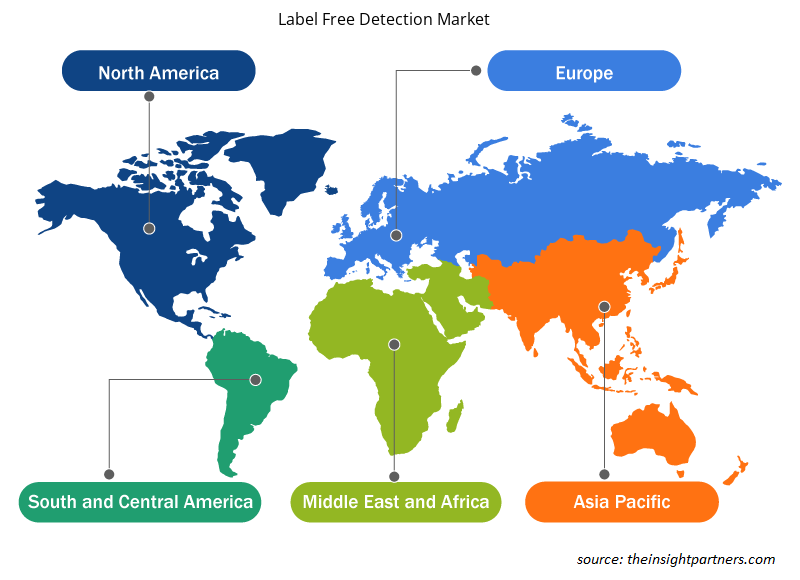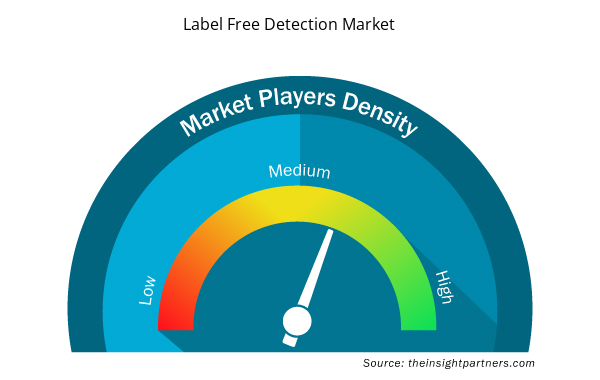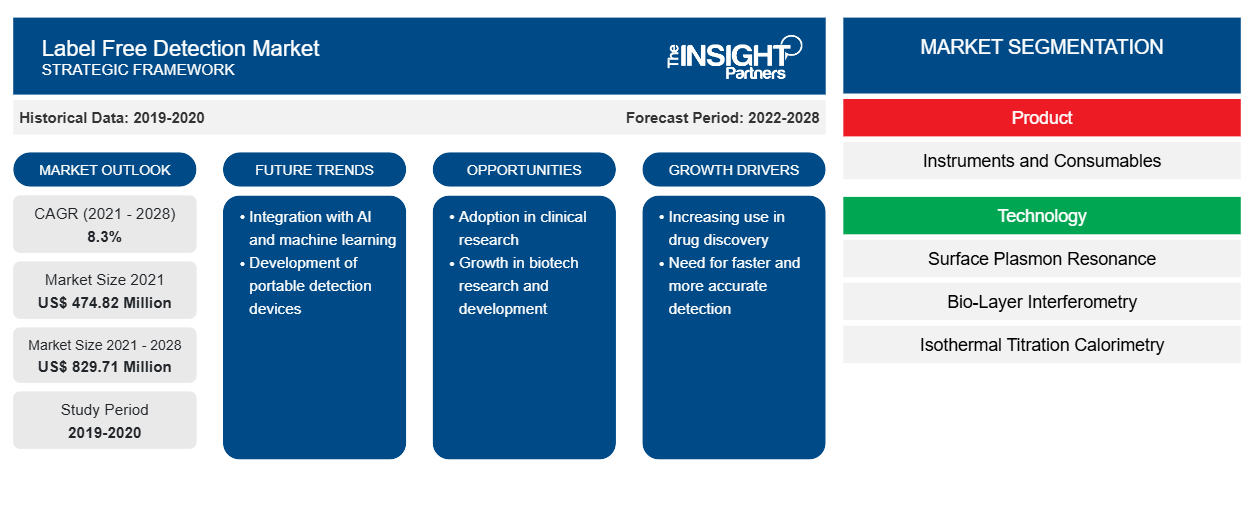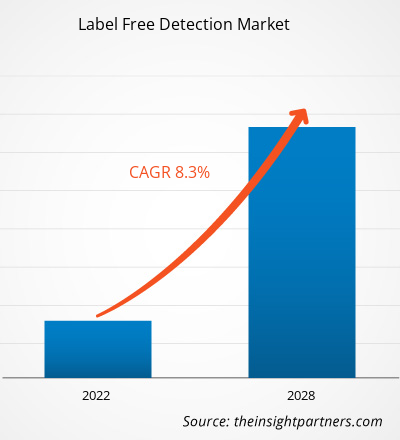无标签检测市场规模预计将从 2021 年的 4.7482 亿美元增至 2028 年的 8.2971 亿美元;预计 2021 年至 2028 年的复合年增长率为 8.3%。
无标记检测 (LFD) 是一种用于发现生物分子及其相互作用的技术。这种方法已成为制药和生物技术行业中一种颇具吸引力的研发工具。无标记技术使用基于阻抗或光学的生物传感器来测量分析物与固定在生物传感器表面的配体结合时的变化。这种方法可以实时监测相互作用,而无需人为操纵单个检测成分。无标记技术的一个决定性特征是用于配体固定的方法。
无标签检测市场根据 产品、技术、应用、最终用户和地域进行细分。按地域划分,市场大致分为北美、欧洲、亚太地区、中东和非洲以及南美和中美洲。该报告提供了对市场的深入分析和见解,强调了市场趋势、技术进步和市场动态等参数,以及对全球领先市场参与者的竞争格局的分析。
市场洞察
通过产学研合作开展的药物发现项目数量不断增加,推动预测期内无标签检测市场增长
制药/生物技术公司与学术中心之间的直接合作正变得越来越普遍。对于学术研究人员和制药研究人员来说,这些合作的好处是显而易见的。制药公司的财政支持提供了稳定的资金,并增加了他们从事有影响力工作的机会。这些合作可能始于为有前途的候选人提供学术研究资金。该策略有助于制药公司以较低的成本和风险填补其投资组合中的空白。一些创新的产学研合作的例子是武田制药与日本京都大学和美国斯坦福大学的合作,以及赛诺菲与加州大学旧金山分校 (美国)。2020 年,Creoptix 与阿德里亚诺·阿古齐教授和苏黎世大学合作,使用 Creoptix WAVE 系统分析 COVID-19 患者中的 SARS-CoV-2 抗体。因此,通过产学研合作开展的药物发现项目数量不断增加,推动了无标记检测市场的增长。
定制此报告以满足您的需求
您可以免费定制任何报告,包括本报告的部分内容、国家级分析、Excel 数据包,以及为初创企业和大学提供优惠和折扣
- 获取此报告的关键市场趋势。这个免费样品将包括数据分析,从市场趋势到估计和预测。
产品洞察
根据产品,全球无标记检测市场分为仪器和耗材。2021 年,耗材部分占据了最大的市场份额。此外,由于无标记检测技术的不断进步以及政府投资增加以促进生物制药和生物技术领域的发展等因素,预计同一部分将在 2021-2028 年期间在市场上实现最高的复合年增长率。
技术洞察
根据技术,全球无标记检测市场细分为表面等离子体共振、生物层干涉法、等温滴定量热法、差示扫描量热法和其他 LFD 技术。2021 年,表面等离子体共振技术细分市场占据了最大的市场份额。此外,预计同一细分市场在 2021-2028 年期间的复合年增长率最高。这种增长归因于该技术的高度灵敏度及其在调节大分子结合时的特异性、亲和力和动力学参数方面的广泛应用。
应用程序洞察
根据应用,全球无标记检测市场细分为结合动力学、结合热力学、内源性受体检测、命中确认、先导物生成和其他应用。2021 年,结合动力学细分市场占据了最大的市场份额。此外,预计同一细分市场在 2021-2028 年期间的复合年增长率最高。推动该细分市场增长的因素包括对具有广泛治疗指数的药物的需求不断增加、结构生物学的进步以及使用无标记检测方法检测冠状病毒的研发活动不断增加。
最终用户见解
根据最终用户,全球无标记检测市场细分为制药和生物技术公司、学术和研究机构、合同研究组织和其他最终用户。2021 年,制药和生物技术公司部门占据了最大的市场份额。此外,预计同一部门在 2021-2028 年期间将在市场上实现最高的复合年增长率。这种增长归因于制药和生物技术公司广泛使用无标记检测技术来研究药物发现中的生物分子相互作用。
产品发布和合作是全球无标记检测市场参与者广泛采用的策略。以下列出了一些近期的关键市场发展:
- 2021 年 8 月,安捷伦科技公司宣布推出安捷伦 Seahorse XF Pro 分析仪,该分析仪采用了先进的实验设计和分析工具,具有面向制药的全新工作流程解决方案。
- 2022年1月,Waters Corporation宣布收购了电荷检测质谱(CDMS)技术和服务的早期开发商Megadalton Solutions, Inc.的技术资产和知识产权。
COVID-19 对北美无标签检测市场的整体影响是积极的。有多种因素,包括 COVID-19 阳性患者发病率增加、研究增长、疫苗产量增加、接种疫苗的结果研究以及许多其他因素。例如,发表在《美国化学学会杂志》(JACS)上的一项研究展示了完整病毒体的无标签数字检测。研究表明,无标签生物传感方法可以快速检测和量化人类唾液中的完整病毒,分辨率达到单病毒体。这些病例主要导致美国、加拿大和墨西哥等国家对新诊断方法的需求。因此,北美的无标签检测市场受到 COVID-19 的积极影响。
无标签检测市场区域洞察
Insight Partners 的分析师已详尽解释了预测期内影响无标签检测市场的区域趋势和因素。本节还讨论了北美、欧洲、亚太地区、中东和非洲以及南美和中美洲的无标签检测市场细分和地理位置。

- 获取无标签检测市场的区域特定数据
无标签检测市场报告范围
| 报告属性 | 细节 |
|---|---|
| 2021 年市场规模 | 4.7482亿美元 |
| 2028 年市场规模 | 8.2971亿美元 |
| 全球复合年增长率(2021 - 2028) | 8.3% |
| 史料 | 2019-2020 |
| 预测期 | 2022-2028 |
| 涵盖的领域 | 按产品
|
| 覆盖地区和国家 | 北美
|
| 市场领导者和主要公司简介 |
|
无标签检测市场参与者密度:了解其对业务动态的影响
无标签检测市场正在快速增长,这得益于终端用户需求的不断增长,这些需求源于消费者偏好的不断变化、技术进步以及对产品优势的认识不断提高等因素。随着需求的增加,企业正在扩大其产品范围,进行创新以满足消费者的需求,并利用新兴趋势,从而进一步推动市场增长。
市场参与者密度是指在特定市场或行业内运营的企业或公司的分布情况。它表明在给定市场空间中,相对于其规模或总市场价值,有多少竞争对手(市场参与者)存在。
在无标签检测市场运营的主要公司有:
- 通用电气
- 珀金埃尔默公司
- 阿美特克公司
- F.霍夫曼-拉罗氏有限公司
- 思百吉
免责声明:上面列出的公司没有按照任何特定顺序排列。

- 获取无标签检测市场顶级关键参与者概览
无标记检测——市场细分
全球无标记检测根据产品、技术、应用、最终用户和地域进行细分。在产品方面,市场细分为仪器和消耗品。基于技术,无标记检测市场细分为表面等离子体共振、生物层干涉法、等温滴定量热法、差示扫描量热法和其他 LFD 技术。基于应用,市场细分为结合动力学、结合热力学、内源性受体检测、命中确认、潜在客户生成和其他应用。基于最终用户,无标记检测市场细分为制药和生物技术公司、学术和研究机构、合同研究组织和其他最终用户。按地域划分,市场大致分为北美、欧洲、亚太地区、中东和非洲以及南美洲和中美洲。
公司简介
- 通用电气
- 珀金埃尔默公司
- 阿美特克公司
- F.霍夫曼-拉罗氏有限公司
- 思百吉
- 梅特勒-托利多
- 安捷伦科技公司
- 沃特世公司
- 赛多利斯公司
- 康宁公司
- 历史分析(2 年)、基准年、预测(7 年)及复合年增长率
- PEST 和 SWOT 分析
- 市场规模价值/数量 - 全球、区域、国家
- 行业和竞争格局
- Excel 数据集


- Europe Tortilla Market
- Batter and Breader Premixes Market
- Virtual Production Market
- Dairy Flavors Market
- Hydrogen Storage Alloys Market
- Piling Machines Market
- Space Situational Awareness (SSA) Market
- Print Management Software Market
- Vision Guided Robotics Software Market
- Intraoperative Neuromonitoring Market

Report Coverage
Revenue forecast, Company Analysis, Industry landscape, Growth factors, and Trends

Segment Covered
This text is related
to segments covered.

Regional Scope
North America, Europe, Asia Pacific, Middle East & Africa, South & Central America

Country Scope
This text is related
to country scope.
常见问题
The label free detection market majorly consists of the players such as General Electric; Perkin Elmer, Inc.; AMETEK Inc.; F. HOFFMANN-LA ROCHE LTD; Spectris; METTLER TOLEDO; Agilent Technologies, Inc.; Waters Corporation; Sartorius AG; Corning Incorporated.
The global label free detection market based on product, is segmented into instruments and consumables. The consumables held the largest share of the market in 2021 and the same segment register the highest CAGR during the forecast period.
The factors that are driving and restraining factors that will affect the label free detection market in the coming years. Factors such as the introduction of high-tech products, and growing number of drug discovery programs through academic-industrial partnerships are driving the market. However, the high cost of LFD instruments is hampering the market growth.
Label-Free Detection (LFD) is a technique used for discovering biomolecules and their interactions. This method has emerged as an attractive research and development tool in the pharmaceutical and biotech industry. Label-free technology uses impedance- or optics-based biosensors to measure the changes upon analyte binding to a ligand immobilized on a biosensor surface. This approach enables the interaction to be monitored in real-time without manipulating the individual assay components artificially. A defining feature of label-free technology is the method used for ligand immobilization.
Trends and growth analysis reports related to Life Sciences : READ MORE..
The List of Companies - Label Free Detection Market
- General Electric
- Perkin Elmer, Inc.
- AMETEK Inc.
- F. HOFFMANN-LA ROCHE LTD
- Spectris
- METTLER TOLEDO
- Agilent Technologies, Inc.
- Waters Corporation
- Sartorius AG
- Corning Incorporated
The Insight Partners performs research in 4 major stages: Data Collection & Secondary Research, Primary Research, Data Analysis and Data Triangulation & Final Review.
- Data Collection and Secondary Research:
As a market research and consulting firm operating from a decade, we have published and advised several client across the globe. First step for any study will start with an assessment of currently available data and insights from existing reports. Further, historical and current market information is collected from Investor Presentations, Annual Reports, SEC Filings, etc., and other information related to company’s performance and market positioning are gathered from Paid Databases (Factiva, Hoovers, and Reuters) and various other publications available in public domain.
Several associations trade associates, technical forums, institutes, societies and organization are accessed to gain technical as well as market related insights through their publications such as research papers, blogs and press releases related to the studies are referred to get cues about the market. Further, white papers, journals, magazines, and other news articles published in last 3 years are scrutinized and analyzed to understand the current market trends.
- Primary Research:
The primarily interview analysis comprise of data obtained from industry participants interview and answers to survey questions gathered by in-house primary team.
For primary research, interviews are conducted with industry experts/CEOs/Marketing Managers/VPs/Subject Matter Experts from both demand and supply side to get a 360-degree view of the market. The primary team conducts several interviews based on the complexity of the markets to understand the various market trends and dynamics which makes research more credible and precise.
A typical research interview fulfils the following functions:
- Provides first-hand information on the market size, market trends, growth trends, competitive landscape, and outlook
- Validates and strengthens in-house secondary research findings
- Develops the analysis team’s expertise and market understanding
Primary research involves email interactions and telephone interviews for each market, category, segment, and sub-segment across geographies. The participants who typically take part in such a process include, but are not limited to:
- Industry participants: VPs, business development managers, market intelligence managers and national sales managers
- Outside experts: Valuation experts, research analysts and key opinion leaders specializing in the electronics and semiconductor industry.
Below is the breakup of our primary respondents by company, designation, and region:

Once we receive the confirmation from primary research sources or primary respondents, we finalize the base year market estimation and forecast the data as per the macroeconomic and microeconomic factors assessed during data collection.
- Data Analysis:
Once data is validated through both secondary as well as primary respondents, we finalize the market estimations by hypothesis formulation and factor analysis at regional and country level.
- Macro-Economic Factor Analysis:
We analyse macroeconomic indicators such the gross domestic product (GDP), increase in the demand for goods and services across industries, technological advancement, regional economic growth, governmental policies, the influence of COVID-19, PEST analysis, and other aspects. This analysis aids in setting benchmarks for various nations/regions and approximating market splits. Additionally, the general trend of the aforementioned components aid in determining the market's development possibilities.
- Country Level Data:
Various factors that are especially aligned to the country are taken into account to determine the market size for a certain area and country, including the presence of vendors, such as headquarters and offices, the country's GDP, demand patterns, and industry growth. To comprehend the market dynamics for the nation, a number of growth variables, inhibitors, application areas, and current market trends are researched. The aforementioned elements aid in determining the country's overall market's growth potential.
- Company Profile:
The “Table of Contents” is formulated by listing and analyzing more than 25 - 30 companies operating in the market ecosystem across geographies. However, we profile only 10 companies as a standard practice in our syndicate reports. These 10 companies comprise leading, emerging, and regional players. Nonetheless, our analysis is not restricted to the 10 listed companies, we also analyze other companies present in the market to develop a holistic view and understand the prevailing trends. The “Company Profiles” section in the report covers key facts, business description, products & services, financial information, SWOT analysis, and key developments. The financial information presented is extracted from the annual reports and official documents of the publicly listed companies. Upon collecting the information for the sections of respective companies, we verify them via various primary sources and then compile the data in respective company profiles. The company level information helps us in deriving the base number as well as in forecasting the market size.
- Developing Base Number:
Aggregation of sales statistics (2020-2022) and macro-economic factor, and other secondary and primary research insights are utilized to arrive at base number and related market shares for 2022. The data gaps are identified in this step and relevant market data is analyzed, collected from paid primary interviews or databases. On finalizing the base year market size, forecasts are developed on the basis of macro-economic, industry and market growth factors and company level analysis.
- Data Triangulation and Final Review:
The market findings and base year market size calculations are validated from supply as well as demand side. Demand side validations are based on macro-economic factor analysis and benchmarks for respective regions and countries. In case of supply side validations, revenues of major companies are estimated (in case not available) based on industry benchmark, approximate number of employees, product portfolio, and primary interviews revenues are gathered. Further revenue from target product/service segment is assessed to avoid overshooting of market statistics. In case of heavy deviations between supply and demand side values, all thes steps are repeated to achieve synchronization.
We follow an iterative model, wherein we share our research findings with Subject Matter Experts (SME’s) and Key Opinion Leaders (KOLs) until consensus view of the market is not formulated – this model negates any drastic deviation in the opinions of experts. Only validated and universally acceptable research findings are quoted in our reports.
We have important check points that we use to validate our research findings – which we call – data triangulation, where we validate the information, we generate from secondary sources with primary interviews and then we re-validate with our internal data bases and Subject matter experts. This comprehensive model enables us to deliver high quality, reliable data in shortest possible time.


 获取此报告的免费样本
获取此报告的免费样本